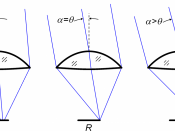1.IntroductionA contract is formed in any transaction in which one or both parties make a legally enforceable promise. Under the modern approach, an offer invites acceptance by any means reasonable under the circumstances, unless otherwise indicated by language or circumstances. This approach reflects the fact that many offers do not specify whether acceptance is to be by full performance or promise.
Unless the offeror indicates otherwise, the offeree may use any medium that is reasonable under the circumstances or, in non-goods contracts, the same medium as was used to communicate the offer or any other medium "customary in similar transactions at the time and place the offer is received."2. General RuleThe general rule is that an acceptance must be communicated to the offeror. The acceptance is generally only validly communicated when it is actually brought to the attention of the offeror. It is for the offeree to ensure that communication has been made.
Modern mechanical methods of communication represents this rule.
Consequences of this rule* The offeror can not, in other words impose silence as acceptance by the offeree.
* The offeror can waive or ignore this requirement for actual communication to him.
* The offeror may lay down a particular method of communication he desires.
Elaboration* In the case of instantaneous communication, such as telephone and telex, the acceptance takes place at the moment the acceptance is received by the offeror and at the place at which the offeror happens to be.
* The communication of a proposal is complete when it comes to the knowledge of the person to whom it is made. The communication of an acceptance is complete, as against the proposer, when it is put in a course of transmission to him, so as to be out of the power of the acceptor; as against the acceptor, when it comes to the knowledge of the proposer.
3.ApplicationFollowing case may be discussed for application of this rule:a.In the case of Manchester Diocesan Council for Education V. Commercial and General Investments Ltd [1969] 3 All ER 1593. The claimant decided to sell some property by tender and inserted a clause in the form of tender stating that the person whose bid was accepted would be informed by means of a letter sent to the address given in the tender. The defendant completed the form of tender and sent it to the claimant. The claimant decided to accept the defendant's tender and sent a letter of a acceptance to the defendant's surveyor but not to the address on the tender. It was held that communication to the address in the tender was not the sole permitted means of communication of acceptance and that therefore a valid contract had been concluded. The defendant was not disadvantaged in any way by notification being given to its surveyor and, in any case, the stipulation had been inserted by the claimant, not the defendant, and so it was open to the claimant to waive strict compliance with the term provided that the defendant was not adversely affected thereby.
b.Acceptance must generally be communicated to the offeror, the acceptance is generally only validly communicated when it is actually brought to the attention of the offeror. in the case, Lord Denning J said in Entrors v Miles Far East Corp (1955) if an oral acceptance is drowned out by an over flying aircraft, such that the offeror can not hear the acceptance, then there is no contract unless the acceptor repeats his acceptance once the aircraft passed over.
c.In the case of Brinkibon Ltd. v. Stahag Stahl (1983) negotiations were held internationally, using a variety of communication devices. The court first stated the general rule that "a contract is formed when acceptance is communicated by the offeree to the offeror. If it is necessary to determine where a contract is formed, this should be at the place where acceptance is communicated to the offeror." It then decided that in cases "of instantaneous communication the contract (if any) was made when and where the acceptance was received." This is an exception to the "postal rule." So the "postal rule" does not apply to fax transmissions4.Analysis/ Comments4.1Prescribed method of acceptanceWhere the offeror prescribes a specific method of acceptance, the general rule is that the offeror is not bound unless the terms of his offer are complied with. However the offeror who wishes to state that he will be bound only if the offer is accepted in a particular way must use clear words to achieve this purpose. Where the offeror has not used sufficiently clear words a court will hold the offeror bound by an acceptance which is made in a form which is no less advantageous to him than the form which he prescribed.
4.2AcceptanceAcceptance is the moment of contract. Acceptance determines when a contract comes into being. In some cases it may also be necessary to determine where a contract comes into being. The place of acceptance may answer this. After all, it is the difference between contract and no contract.
4.3Postal Acceptance RuleThe general rule for acceptance by post is that they take effect when they are posted, rather than when they are communicated.
4.4How to get defense in Postal Rule ?Firstly - An offeror may avoid the postal rule by making it a term of their offer that acceptance will only take effect when it is communicated to them. In Holwell Securities v Hughs (1974) the defendant proposed to sell his property and the offer stated " the acceptance have to be notified in writing ' the plaintiff accepted and sent it but never reached despite being properly addressed the court held that Notice means communication therefore, postal rule will not apply.
Secondly - The offeror can avoid the operation of the rule by stating that the acceptance will only be effective when it actually reaches him.
Thirdly - When an acceptance is mede by an instant mode of communication, such as telephone or telex the postal rule does not apply for instance in Entores v Miles far East Corporation (1955) both the parties used instant responding machineries as means of communication for contract later on while the plainfiff raised question about breach of contract in court, the court held that - because telex allows almost instant communication , the parties were in the same position as if they had negotiated each others presence or over the telephone, so, the postal rule did not apply and acceptance did not take effect until it had been received by the plaintiff.
4.5 Communications that do not constitute offersThe following types of communications, which do not manifest intent to be contractually bound, do not constitute offers:* Opinions about future results, including professional opinions* Statements of intention (including letters of intent which merely memorialize negotiations)* Invitations to submit a bid* Price estimates* Advertisements, catalogs and mass mailings* An auction is "with reserve" unless announced to the contrary.
5.ConclusionThe present world is highly commercialized and day by day the aspect of contract is gaining momentum. In the day-to-day life every relationship of human being is based upon contractual obligation. Rules of communications plays a vivid role in the formation of contracts. Justified and careful application of the rules can always protect the interest of any party entering into a contract.
Bibliography:1.Book "Contract Law" by Ewan Mckendrick.
2."Contract handouts" by Khaled H Chowdhury, Barrister-at-law.
3.Documents from internet.





